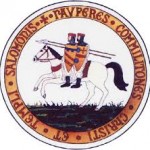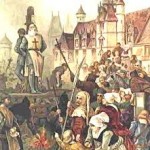The rough routes taken by pilgrims to Jerusalem were left unprotected from Saracen marauders and Christian bandits until 1118 when a small band of seven remaining Knights under the leadership of Hugo de Payens bound themselves in a holy Brotherhood in arms. They entered into a solemn agreement to aid one another in the protection of these pilgrims on their dangerous route to the Holy City. Baldwin II, King of Jerusalem, granted them quarters near the royal palace, and, as the site was traditionally that of Solomon’s Temple, they came to be known as “Knights of the Temple”.
Their seal shows two knights on one horse, not perhaps as some say to show how poor they were, but to highlight their overwhelming sense of Brotherhood. If one knight’s horse died in battle and its rider faced imminent death in the midst of the enemy, no other knight was allowed to leave the field of battle. The nearest knight was obliged by code of honour to come to the aid of his brother, no matter the cost. The rider is shown leaving the battlefield sharing his horse with a Fellow Brother. It is interesting to note that Templars were allocated up to three horses. They were not so poor as their name implies.
The Order became a favoured charity throughout Christendom and grew rapidly in membership and power. Templar knights, in their distinctive white mantles with a red cross, were among the most skilled fighting units of the Crusades. Their monastic vows and unselfish defence of the Holy Land allowed them to amass great wealth through gifts from their grateful benefactors. Since the Knights had taken a vow of poverty, they re-invested their wealth. Non-combatant members of the Order managed a large economic infrastructure throughout Christendom using financial techniques that became an earlyform of banking. Money could be deposited at one Preceptory and made available at another without the traveller incurring the risk of robbery during his journey. In these financial transactions a high reputation for financial integrity was sustained. The Templars constructed fortifications across Europe and the Holy Land and soon had an army and a fleet of ships as well as surplus money.On leaving the Holy Land in 1272 after the disastrous end to the last Crusade with the fall of the city of Arcre, the Templars had taken temporary refuge on the island of Cyprus.After failing to regain a footing in Palestine the Knights retired from Cyprus to their different Commanderies in Europe, among which those in France were the most wealthy and numerous.
During this period, Philip IV, or Philip the Fair, was king of France and Clement V was Pope. One was the paragon of avarice and the other of pure treachery. The King bound Clement to eradicate the Templars, an Order of whose power he was envious and whose wealth he coveted. Pope Clement, residing in Poitiers summoned the heads of the military Orders to appear before him for the purpose, as he deceitfully pretended, of planning a new Crusade.
James de Molay, the Grand Master of the Templars, presented himself at the papal court. While there Phillip referred a series of charges against the Order which demanded its suppression and the punishment of its leaders. On the 13th of October, 1307, the Grand Master and one hundred and thirty-nine Knights were arrested in the palace of the Temple in Paris, along with other simultaneous arrests made in various parts of France. The captured Templars were enchained and thrown into prison. They were starved and were refused the consolation of the religion they had fought to protect.
The infamous Pope Clement launched a bull of excommunication against all persons who should give the Templars aid or protection. Needless to say, their trials were horrific farce.
Torture, life imprisonment and execution were their ending. One hundred and thirteen Knights were burnt at the stake.
On the 11th of March, 1314. Jacques de Molay, the Grand Master of the Order, having suffered six and a half years of brutal imprisonment, was publicly burnt at the stake in front of the Cathedral of Notre Dame.
Vea este documental que le dará una perspectiva profundida de la historia de los Caballeros Templarios http://youtu.be/z8-bVf8XK5c




